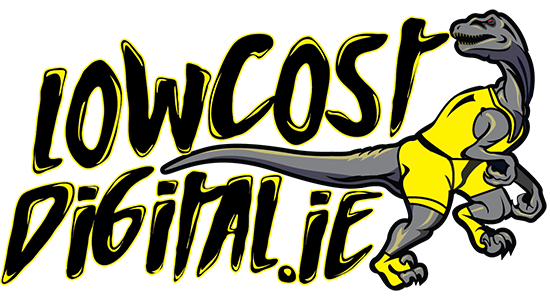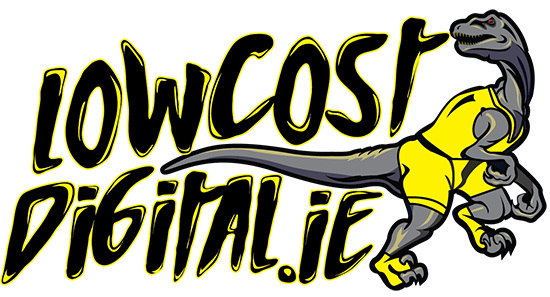Key Highlights
- Understand the importance of web design and how contributes to brand identity user experience
- Summarize the state of knowledge in web design the best practices for creating a plan
- Learn about the key takeaways for beginners, including choosing a domain name and content management system
- Identify the knowns and unknowns in web design plans and the pain points that might arise
- Discover essential tools and resources needed for web design planning, such as a content management system and project management software
- Set clear goals and objectives for your web design plan, aligning them with your business goals and user experience
- Follow a step-by-step guide to creating a web design plan, including gathering inspiration, sketching ideas, and testing design usability
- Highlight the services offered by www.lowcostdigital.ie for web design needs, including web development, social media marketing, and content strategy
- Incorporate SEO and content strategy into your web design plan to optimize your website for search engines and create engaging content
- Avoid common pitfalls in web design, such as overlooking mobile responsiveness and ignoring user experience principles
- Review and improve your web design by seeking feedback from peers and users and making necessary design adjustments
- Answer frequently asked questions about starting a web design plan, updating web design, designing a website without coding skills, and best practices for responsive design
- Conclude the blog by summarizing the key points discussed and emphasizing the importance of web design planning for beginners
Introduction
Web design planning is a crucial aspect of creating a successful website. Understanding the key elements of website design and its significance is essential for beginners embarking on this journey. This process involves clearly defining your objectives, selecting the right tools, and mapping out your website structure. By following a structured approach and incorporating best practices, you can ensure that your website effectively communicates your brand identity and engages your target audience. Let’s delve into the fundamental steps involved in crafting a compelling web design plan to set the stage for a successful website development process. www.lowcostdigital.ie
Understanding Web Design Planning
Developing a comprehensive web design plan involves thorough understanding of the website planning process. This includes defining the website structure, user journey, and content strategy. A successful web design project requires consideration of user personas, brand identity, and information architecture. By delving into the intricacies of web design planning, you can create a website that not only looks visually appealing but also caters to the needs of your target audience. Understanding the core principles of web design planning is crucial for a smooth development process. Effective planning forms the foundation for a visually stunning and functional website that aligns with your business goals and brand personality.
Clearly Describing Web Design and Its Importance
Web design is crucial for crafting a visually appealing and functional website that resonates with your target audience. It involves designing the layout, structure, and overall look of a website to ensure a seamless user experience. By focusing on website planning, you can create a site that not only looks great but also drives traffic and engages visitors. A well-executed web design plan can help establish your brand identity online and set you apart from competitors. Embracing the development process through effective web design is the best way to bring your business goals to life and create a successful online presence. www.lowcostdigital.ie
Summarizing the State of Knowledge in Web Design
The state of knowledge in web design encompasses a vast array of NLP terms and best practices, drawing from website planning and development processes. Understanding user journeys, brand identity, and visual elements are essential. Incorporating SEO strategies and content management systems play a pivotal role. Balancing website structure, information architecture, and visual references is crucial. Recognizing the importance of user personas, brand guidelines, and content strategy shapes successful websites. Attention to mobile responsiveness, user experience, and search engine optimization is paramount. Iterative design and feedback loops refine the final copy and design. Continual learning and adaptation to evolving technologies are key in web design.
Key Takeaways for Beginners
Understanding the fundamentals of web design planning and its role in successful website creation is crucial for beginners. Start by clearly defining your goals and objectives, utilizing essential tools and resources, and identifying the unknowns in the web design process. Gather inspiration, sketch initial ideas, and create a visual moodboard to guide your design. Remember to focus on user experience, incorporate SEO strategies, and avoid common pitfalls like overlooking mobile responsiveness. Review and iterate on your design by seeking feedback and making necessary adjustments for continual improvement. These key takeaways will help beginners navigate the complexities of web design planning effectively.
What is Known About Web Design Plans
Web design plans encompass the roadmap for constructing a successful website that resonates with the target audience. By amalgamating website design, structure, and user experience, these plans set the stage for an engaging and functional online presence. They involve crafting a visual identity, defining user personas, and implementing best practices for a successful website. Understanding user journeys, information architecture, and brand guidelines are pivotal components in creating effective web design plans. Incorporating SEO strategies and a solid content strategy are known essentials for enhancing website visibility and user engagement. With a focus on aesthetics and functionality, web design plans aim to fulfill business goals and create an impactful digital presence. www.lowcostdigital.ie
Identifying the Unknowns in Web Design
Understanding the unknowns in web design involves recognizing the challenges that may arise during the development process. Despite meticulous planning, certain aspects, such as user personas, brand guidelines, or content strategy, can present unforeseen hurdles. Navigating through these uncertainties requires flexibility and adaptability, as each project plan may bring its unique set of complexities. Anticipating and addressing these potential pain points ensures a smoother web design journey, leading to a more cohesive and successful website launch. By acknowledging and proactively managing these unknown elements, web designers can enhance the overall user experience and create websites that truly resonate with their target audience.
Preparing for Your Web Design Plan
Essential tools and resources play a vital role in preparing for your web design plan. Setting clear goals and objectives is equally crucial. Before diving into the development process, ensure you have the right project plan in place. Define your brand identity, business goals, and user personas to align your website design with your target audience. Remember, a well-structured website plan template serves as a roadmap for success. Emphasize user experience and information architecture to create a website structure that resonates with your brand personality. By focusing on these aspects, you set the stage for a successful website launch. www.lowcostdigital.ie
Essential Tools and Resources Needed
To embark on a successful web design journey, essential tools and resources are indispensable. As you dive into the intricate world of website design, having the right utilities at your disposal can make a significant impact on your efficiency and outcomes. Tools such as project management software, graphic design programs, and prototyping tools streamline the development process. Additionally, access to a reliable content management system simplifies content updates and modifications, ensuring a seamless user experience. Don’t overlook the importance of a design brief template to outline project goals and expectations clearly. These resources serve as the building blocks for crafting a visually appealing and user-friendly website that aligns with your brand identity.
Setting Clear Goals and Objectives
To set clear goals and objectives in your web design plan, it is crucial to align them with your business goals and brand identity. Identify your target audience and their pain points to tailor the user experience effectively. Define the desired user journey and ensure that the website structure and information architecture support it. Incorporate SEO strategies and content management systems to optimize search engine visibility. Establish measurable metrics for success and consider how your website design can generate inbound leads. By outlining specific objectives and timelines, you can stay focused throughout the development process and create a website that meets your business objectives successfully. www.lowcostdigital.ie
Step-by-Step Guide to Creating a Web Design Plan
Step 1: Gathering Inspiration and Defining Style is crucial. Sketch Initial Ideas for clarity. Choose the Right Tools and Software wisely. Create a Visual Moodboard to guide design direction. Draft a Site Map and Wireframe to organize content. Design Engaging UI Elements for user interaction. Test Design Usability for seamless functionality. Each step builds the foundation for a successful web design plan, ensuring a coherent and visually appealing website that resonates with the target audience. This meticulous process sets the stage for a smooth development process, reflecting the best practices in website planning and design.
Step 1: Gathering Inspiration and Defining Style
To kick off your web design plan, the first step is gathering inspiration and defining your style. It’s crucial to seek visual references and explore different ways to shape your website’s look. Start by creating a design brief that outlines your brand personality and sets the tone for your project. Color schemes and a collection of images can provide a great visual inspiration. Utilize free photos and formatting tools to build a compelling visual identity. By defining your style early on, you lay the foundation for a successful website that resonates with your target audience’s preferences and expectations.
Step 2: Sketching Your Initial Ideas
When starting your web design plan, step 2 involves sketching your initial ideas. This crucial phase allows you to visualize layout concepts, elements placement, and overall structure before diving into detailed development. Utilize design software or traditional sketching techniques to map out your webpage’s basic framework. By sketching your ideas, you can quickly iterate and fine-tune the initial layout without investing significant time and resources. Collaborate with your team or clients during this stage to gather feedback and ensure alignment with project goals. Remember, the sketches are a starting point, helping you translate abstract concepts into tangible design directions. www.lowcostdigital.ie
Step 3: Choosing the Right Tools and Software
For web design beginners, selecting the right tools and software is crucial in the development process. Consider your target audience and project goals when choosing between different content management systems and design software. Identify the pain points in your website plan and find tools that address them effectively. Look for platforms that align with your brand identity and support a seamless user experience. Make sure the tools you pick cater to search engine optimization needs as well. This step lays the foundation for a successful website, so take the time to research and select the tools that best suit your needs and skill level.
Step 4: Creating a Visual Moodboard
Creating a visual moodboard is a crucial step in your web design plan. By collecting a range of visual references, color schemes, and images, you can establish the visual identity of your website. This process helps in defining the overall look and feel, ensuring consistency across all visual elements. A moodboard acts as a visual guide that aligns your design choices with your brand personality and business goals. It serves as a reference point throughout the design process, guiding you in creating a cohesive and engaging website that resonates with your target audience. Utilizing a collection of images and color palettes allows you to set the tone for your website and maintain a cohesive design language. www.lowcostdigital.ie
Step 5: Drafting a Site Map and Wireframe
When creating a web design plan, a crucial step is drafting a site map and wireframe. A site map outlines the structure of your website, displaying how different pages relate and connect. It serves as a navigational guide for users and search engines, enhancing the user journey and SEO. On the other hand, a wireframe is a visual representation of the website’s layout, focusing on functionality and user experience without design elements. It helps in planning the placement of content and features. Both the site map and wireframe lay the foundation for the website structure, ensuring a well-organized and user-friendly design. These steps are essential in the development process for a successful website.
Step 6: Designing Engaging UI Elements
To design engaging UI elements, consider the user journey and experience. Use color schemes and visual elements that resonate with your brand identity. Ensure your design aligns with your brand personality and guidelines. Incorporate best practices for visual design, such as creating visually appealing landing pages and using high-quality visual references. Pay attention to detail in the design brief and stay consistent with your design choices. Utilize tools for formatting and finalizing the design. The final UI elements should not only be visually appealing but also enhance the overall user experience.
Step 7: Testing Design Usability
To ensure a seamless user experience, testing design usability is crucial in the web design process. By employing various NLP approaches, including user journey mapping and user personas, you can identify pain points and refine your website. Conduct A/B testing, gather feedback, and analyze user interactions to optimize the design for your target audience. Utilize formatting tools and engage in responsive design to enhance user experience on different devices. By testing design usability iteratively, you can create a successful website that aligns with your business goals and resonates with your ideal customers.
Highlighting www.lowcostdigital.ie for Web Design Needs
If you’re looking for top-notch web design services, www.lowcostdigital.ie is your go-to solution. With a focus on user experience, brand identity, and seamless functionality, they excel in delivering aesthetically pleasing and effective websites. Whether you’re a small business or a growing enterprise, their tailored approach ensures your online presence aligns perfectly with your business goals. From website design to content strategy, they cover it all with expertise. You can trust www.lowcostdigital.ie for a visually stunning and user-friendly website that stands out in the digital landscape. Their services cater to every aspect of web design, making them a valuable asset for your online success.
Why Choose www.lowcostdigital.ie for Your Web Design
Www.lowcostdigital.ie is the ideal choice for your web design needs due to their expertise in website design and development. Their tailored solutions cater to your specific business goals, ensuring a website that reflects your brand identity and provides a seamless user experience. By utilizing the best practices in web design and content strategy, they help you stand out in the online market. With a focus on user personas and engaging website elements, www.lowcostdigital.ie ensures that your website not only looks visually appealing but also drives inbound leads. Trust them to transform your online presence into a successful and visually captivating platform. www.lowcostdigital.ie
Services Offered by www.lowcostdigital.ie
At www.lowcostdigital.ie, a range of services cater to diverse web design needs. From creating visually striking websites to optimizing user experience, their expertise extends to crafting engaging website content and implementing SEO strategies. Specialized services also include building brand identity through consistent design elements and enhancing website functionality with innovative solutions. With a focus on user personas and brand guidelines, www.lowcostdigital.ie ensures that every aspect of the website aligns with the client’s goals. By offering comprehensive design and development services, they stand out as a valuable partner for businesses seeking to establish a strong online presence.
Incorporating SEO and Content Strategy
Crafting a successful website involves incorporating SEO and content strategy. By understanding the importance of search engines, web designers can optimize websites for better visibility. Crafting content that complements the design is crucial for engaging the target audience. To enhance user experience and drive traffic, utilizing SEO best practices is essential. Integrating relevant keywords, metadata, and quality content can improve website rankings. Content strategy should align with the brand identity and user personas to create a cohesive online presence. By focusing on SEO and content strategy, web designers can create websites that not only look appealing but also perform well in search engine results.
Basics of SEO for Web Designers
Understanding SEO is crucial for web designers to optimize a website’s visibility on search engines and attract the target audience. Incorporating SEO involves keyword research, meta tags, image optimization, and mobile responsiveness. It’s essential to create high-quality content that aligns with SEO practices to enhance search engine rankings. Understanding the importance of backlinks and internal linking can further improve a website’s credibility in the eyes of search engines. Balancing technical optimization with engaging content is the key to a successful website that ranks well and provides value to users. By implementing SEO best practices, web designers can create websites that meet both user needs and search engine requirements. www.lowcostdigital.ie
Crafting Content that Complements Design
Crafting content that complements design is crucial for a cohesive website. Your content should not only be engaging but also align with the visual elements and user experience. By integrating your brand voice and messaging seamlessly into the design, you create a unified online presence. Consider how your content guides users through the website and supports their journey. Utilize keywords strategically for SEO purposes while maintaining readability. Remember, the ultimate goal is to provide value to your target audience through both design aesthetics and compelling content. Good content enhances the overall user experience and contributes to the success of your web design plan.
Common Pitfalls to Avoid in Web Design
Overlooking Mobile Responsiveness and Ignoring User Experience Principles are common pitfalls in web design. In today’s digital landscape, ensuring your website adapts seamlessly to various devices is crucial. Mobile optimization affects user experience and search engine rankings. Similarly, neglecting fundamental principles of user experience design can lead to high bounce rates and low engagement. Designing solely for desktop without considering mobile users can alienate a significant portion of your target audience. User experience should be at the forefront of your web design plan, encompassing intuitive navigation, fast loading times, and accessible content across all platforms. By avoiding these pitfalls, you can create a website that resonates with users and performs well across devices. www.lowcostdigital.ie
Overlooking Mobile Responsiveness
When creating a website plan, overlooking mobile responsiveness can be a critical mistake. In today’s digital landscape, where mobile usage is prevalent, ensuring that your website functions well on various devices is crucial. Failure to optimize for mobile can lead to a poor user experience, high bounce rates, and decreased visibility on search engines. Responsive design adapts your website layout to different screen sizes, offering a seamless experience for all users. By addressing mobile responsiveness early in your web design plan, you enhance user satisfaction and engagement, ultimately driving the success of your online presence. Make mobile optimization a priority to create a website that caters to all visitors.
Ignoring User Experience Principles
When designing a website, one common pitfall to avoid is ignoring user experience principles. User experience (UX) is crucial for the success of a website as it directly impacts how visitors interact with and perceive the site. Neglecting UX principles can result in a frustrating and confusing user journey, leading to high bounce rates and low user engagement. Elements such as intuitive navigation, fast loading times, mobile responsiveness, and accessibility are vital aspects of a positive user experience. By prioritizing UX design in your web design plan, you can create a seamless and satisfying browsing experience for your target audience, ultimately driving better results for your website.
Reviewing and Improving Your Design
Seeking feedback from peers and users is crucial in reviewing and improving your design. Iterative design allows for making necessary adjustments based on the received input. This continuous improvement loop enhances the user experience and ensures the final design aligns with the project plan. By actively involving stakeholders, you can address pain points and refine the website design to better meet business goals. Iteratively reviewing your design not only enhances functionality but also strengthens brand identity and user engagement. Incorporating feedback and iterative adjustments are fundamental in creating a successful website that resonates with your target audience and achieves your website planning objectives.
Seeking Feedback from Peers and Users
Seeking feedback from peers and users is crucial in the web design process. Their insights can provide valuable perspectives on usability, aesthetics, and overall user experience. By engaging with your target audience, you can identify potential pain points and areas for improvement in your website design. Feedback helps in making informed decisions to enhance the effectiveness of the website and align it better with user expectations. It also contributes to building a successful website that resonates with your audience and fulfills your business goals. Don’t overlook the significance of feedback loops in refining your design and ensuring a user-centric approach.
Iterative Design: Making Necessary Adjustments
Iterative design involves making necessary adjustments based on feedback to enhance the website continually. It’s an essential part of the web design process, allowing for improvements and refinements over time. By seeking feedback from peers and users, you can identify areas for enhancement and make iterative adjustments for a better user experience. The iterative approach ensures that your website remains current and aligned with your business goals. Making necessary adjustments based on feedback is crucial in fine-tuning your design, ironing out any issues, and keeping your website competitive in the digital landscape.
Conclusion
Crafting a successful website requires careful planning and execution in web design. By understanding the importance of website design and planning, beginners can create an engaging user experience. Remember to incorporate SEO strategies and quality content to enhance your website’s visibility. Avoid common pitfalls like overlooking mobile responsiveness and user experience principles. Continuously review and improve your design by seeking feedback and making necessary adjustments. With the right tools, clear goals, and a solid project plan, you can create a visually appealing website that aligns with your business goals and brand identity. Start your web design journey today and watch your online presence flourish. Choose www.lowcostdigital.ie for expert assistance in fulfilling your web design needs.
Frequently Asked Questions
What Are the First Steps in Starting a Web Design Plan?
To start a web design plan, begin by gathering inspiration, defining your style, and sketching initial ideas. Then move on to choosing the right tools, creating a visual moodboard, drafting a site map, designing UI elements, and testing usability. These steps lay the foundation for a successful web design.
How Often Should I Update My Web Design?
To keep your website fresh and engaging, aim to update your web design at least every 2-3 years. Regular updates ensure relevance, modernity, and improved user experience. Consistent updates also align with evolving trends and technologies.
Can I Design a Website Without Coding Skills?
Yes, you can design a website without coding skills using user-friendly website builders like Wix, Squarespace, or WordPress. These platforms offer drag-and-drop interfaces for easy website creation. No coding knowledge is required, making it accessible for beginners.
What Are the Best Practices for Responsive Design?
To ensure a responsive design, prioritize mobile-friendly layouts, optimize images for fast loading, use CSS media queries for flexible styling, and test across various devices. Implement touch-friendly navigation and consider performance optimization techniques like lazy loading.












